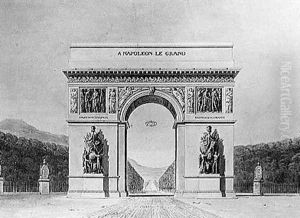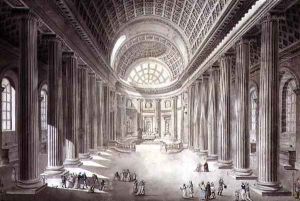Circle of Chalgrin, Jean Francois Therese Paintings
Jean-François-Thérèse Chalgrin was a French architect whose work is emblematic of the Neoclassical style, which sought to revive and reinterpret the principles and aesthetics of ancient Greek and Roman architecture. Born in Paris on October 8, 1739, Chalgrin was educated at the French Academy in Rome, an institution pivotal in shaping the architects and artists who would lead the Neoclassical movement across Europe. His education and experiences in Italy profoundly influenced his architectural style, as did the works of earlier French architects like Jacques-Germain Soufflot, the designer of the Panthéon in Paris, with whom Chalgrin is often compared.
Upon his return to France, Chalgrin worked on various significant projects, showcasing his ability to blend classical rigor with contemporary needs. His most famous work is the Arc de Triomphe in Paris. Commissioned by Napoleon in 1806 to honor the French army, the Arc de Triomphe became one of the most iconic monuments in Paris. Although Chalgrin died in 1811, before the monument was completed, his designs and vision laid the groundwork for its completion in 1836. The Arc's grand scale and detailed reliefs embody the spirit of the Neoclassical movement, celebrating heroism and the ancient past while serving a modern nationalistic purpose.
Beyond the Arc de Triomphe, Chalgrin contributed to the design and construction of several other important buildings and renovations, including works on the Church of Saint-Philippe-du-Roule in Paris, which is noted for its innovative use of space and light, and the renovation of the Palais du Luxembourg. His approach often involved a careful consideration of the site and historical context, integrating new constructions harmoniously with their surroundings. Chalgrin's impact extends beyond his individual projects; he was part of a broader movement that sought to express ideals of clarity, order, and beauty, principles that continued to influence European and American architecture well into the 19th century.
Jean-François-Thérèse Chalgrin's legacy is that of a pioneer in the Neoclassical architectural movement, whose work bridged the gap between the grandeur of ancient architectures and the functional needs of his time. Despite the relatively small number of his completed projects, his influence is seen in the emphasis on symmetry, proportion, and the use of classical elements in later works. Chalgrin passed away in Paris on January 21, 1811, leaving behind a legacy that would forever shape the architectural landscape of France and the Neoclassical movement worldwide.

